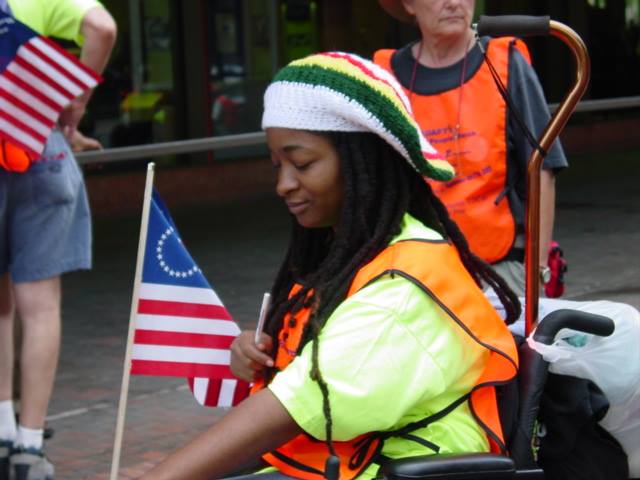The disability rights movement changed my life. I have been benefiting from legislation fought for by disabled activists who came before me since I was a young child. Like Mike Ervin and various other activists, I am a former poster brat, a kid pimped out for profit by the machine that was MDA, While still cute enough to raise them tons of cash. For a long time, my identity was intertwined with what I thought I understood about my life as a disabled person.
I had grown up believing and being told that most if not all of us with neuromuscular disabilities would not survive into adulthood. There was no expectation on my life, so my doctors told me consistently that they had absolutely no idea of the outcome of my life. At the same time, I was internalizing the message I was supposed to be spreading in order to raise money for MDA, the idea that without a cure our lives are not worth living if we survive, at all. Jerry Lewis used the pity model for profit, to make MDA millions. They promised a cure…to make us “normal” and as children we took that to heart. Many of us thought of ourselves as not normal. We believed we were or at least all of our friends with neuromuscular disabilities would die young. For some, there was a belief of no point in attempting to have a future, because it was pointless if death was coming anyway.

This is why films that explore disability history in an accurate and inclusive way are so desperately needed. If nondisabled filmmakers are going to make films that feature disabled stories, including documentaries, disabled people need to be the voices that shape the film. So often, we see disabled people and characters who imbue the nondisabled idea of what disability is about – people pity us, find us inspiring, or they fear us. Seldom are we portrayed as parents, lovers, friends, employable, sexy, self-sufficient, independent, or worthy of dignity. This is the thing I like the most about Defiant Lives. Using archival footage and first person interviews, the film explores the disability rights movement in the United States, Australia, and the UK through the voices and actions of actually disabled people.
I recognize many of the people featured in the film, either as people I know personally, such as my adopted mum, activist, Samantha Connor, and longtime activists like Bob Kafka, Liz Carr, George Teleporos, and Kitty Cone. The film explores areas I’m heavily involved in advocating about including institutionalization and institutional bias, transportation access, the history of the telethon, the charity model, and Jerry’s Orphans, the independent living movement, essential legislation like 504, Australia’s disability scheme, and the ADA, creation of organizations like the Rolling Quads and ADAPT, and various other important moments in disability history.
The film is essential viewing for everyone, and though I am not usually emotional when watching films, I felt very emotional at certain sections that resonated so personally with my own life and my own activism. This was my life, my friends, my family explaining the kind of oppression, neglect, hatred, exclusion, and intolerance we’ve been facing our entire lives simply because we’re disabled. At the same time, I can’t completely get behind this film without criticizing and discussing where it fails. There is so little made about us that is done in a positive way, that also includes us, and appears to let our voices lead the conversation, but the film is exclusionary of certain groups of disabled people.
The disability community has a huge inclusion problem when it comes to marginalization. The most visible exclusion is the lack of people of color in the main narrative for this film. Where are the disabled black and brown activists who have been fighting beside all of us white activists since the beginning of the disability rights movement? You can see black and brown people engaged in archival footage actively protesting, but not one of them is interviewed or is included beyond what is available in the archives. These are some of the folks that personify what it means to live “Defiant Lives” and yet their voices and presence are excluded.
Why is there no coverage of Anita Cameron, a legend here in the United States for her work with ADAPT, Not Dead Yet, and other disability organizations? I’m pretty certain Anita holds a record for some of the most arrests in the history of ADAPT. She has been arrested well over 100 times, protesting for our freedom. She often leads training workshops, and I’ve actually had the honor of leading discussions/training on intersectionality and disability with her. Anita has written about continued exclusion on her blog, when she highlights the fact that black and brown disabled people were fighting alongside white disabled people for the ADA, yet they are seldom included in the history being written and filmed about it.
Where is Alice Wong, a San Francisco activist who created the Disability Visibility Project, and has been helping to archive disability history through audio, social media, and on the web> There are plenty of activists here in the U.S. alone like German Parodi, Jensen Carabello, Lydia Brown, Leroy Moore, Finn Gardiner, Dara Baldwin, Sandy Ho, Stacey Milbern, Victoria Rodríguez-Roldán, etc. That is not including disabled POCs in the UK or Australia. Why is not one of them included?!
What is also missing from the discourse is that many activists, especially those in the United States, started out as civil rights activists. Many early ADAPT activists did not realize that disability rights were something to fight for initially. As a result, several early disability rights activists were engaged in the civil rights movement first. That is why so much of our movement has evolved from the practices of civil rights including nonviolent civil disobedience. We have taken strategies, expressions, chants,and the overall movement is based on the fight for civil rights. We cannot remove ourselves from the work of black and brown activists, because our entire movement is based upon their work.
It also highlights how LGBTQ disabled activists and discussion about intersectionality are nearly absent. The filmmakers are Australian and they did not include the work in the sexual liberation of disabled people by Australian disability activists like Jax Jacki Brown? That could have elevated the story even further. What about the history of activists like Laura Hershey and her partner, Robin Stevens, Corbett O’Toole, and several of the black and brown activists I listed before, who are also LGBTQ such as Anita Cameron, Stacey Milbern, Victoria Rodríguez-Roldán, and Lydia Brown?! There are many disabled LGBTQ activists, who are doing intersectional work that is imperative to disabled liberation, and yet intersectionality, in general, is excluded from this film.
I really like much of the content that is in Defiant Lives. It features real disabled people talking about important disability history. This is history that we need to teach in our schools. This is a history that every person needs to learn. I just think that when we’re crafting this history, unlike the rest of history we’re taught in schools, I would hope the disability community could do better and not whitewash it.
Disabled people come in all races, gender identities, sexual orientations, ethnic origins, socioeconomic statuses, and age brackets. So many of us are living defiant “intersectional” lives. We just need to make sure all of those voices are heard no matter what.
Note: I have been told that activist and Krip Hop Nation founder, Leroy Moore, is addressing the lack of inclusion with the filmmakers, and will also be a part of a panel on the film! While Defiant Lives should be viewed, especially by nondisabled people who need to learn the basics of the disability rights movement and our history, it is my hope that future filmmakers will learn from both the powerful moments of this film, and non-inclusive ones, for future documentaries about our history.

Comments